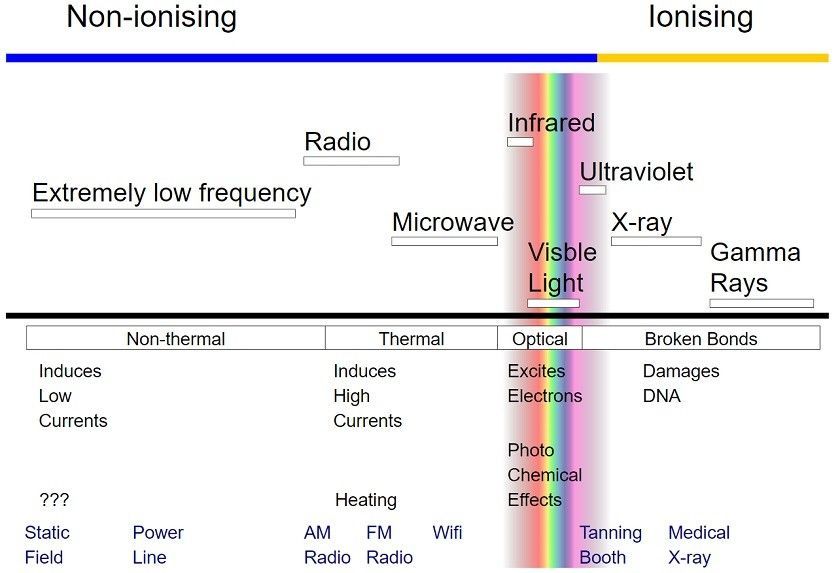5G Radiation and Skin Cancer

This article focuses on the subject of 5G radiation, a non-ionizing electromagnetic radiation. Because 5G radiation is so small, it does not have the ability to break chemical bonds in biological tissues or trigger any modifications to cells. It isn't known whether the effects of 5G radiation alter the risk of developing skin cancer, and no evidence exists to suggest that it can cause other disease.
Millimeter-wave radiation with high frequency
High-frequency millimeter wave radiation from mobile phones and wireless networks may cause health effects to human beings. There are a few different ways this radiation could be harmful. In certain instances radiation may cause damage to the person's DNA. In other cases the radiation may cause harm to other areas in the human body including the brain.
Recent studies have revealed that 5G technology may cause thermal heating in tissues. In the aftermath, scientists from International Council on Non-Ionizing Radiation Protection (ICNIRP) has asked for a review of existing safety standards for biological and thermal radiation. The current standards of exposure don't protect people from excessive heating when exposed to millimeter wave pulses.
Skin cancer risk
There is no definitive answer to the issue of whether radiation from 5G could cause skin cancer. It is thought that 5G RF-EMFs behave as high-LET ionizing radiations. This means that they can produce high levels of free radicals that can be found in the skin. 5g radiation symptoms FCC hasn't issued any specific guidelines on the risks of 5G technology. Consequently, Click for info continues.
Although there are a number of studies that examine the effects of radio waves that are higher frequency on the human body but they've remained limited in the scope. However, there is concern over the effects of millimeter-wavelength exposure on oxidative stress and gene expression. The effects could extend to the skin as well as other organs, like the brain.
Impact on other diseases
A new generation of wireless technology called 5G is rapidly expanding however, scientists are warning of its potential health risks. 5G technology is expected to significantly increase the amount of electromagnetic radiation found in our environment. This is a concern that has sparked debates in many nations which includes Switzerland. In September 2017 390 scientists and doctors supported a motion for a moratorium on 5G deployment. This call was ignored by the European Commission, which is in charge of controlling the use of technology like 5G.
Therefore, more research is needed to study the health implications of 5G. While we wait, studies have shown that 5G isn't causing the same negative effects in humans as radiation from older mobile networks. Additionally, it does not transmit the new coronavirus type. Additionally it does not make people more vulnerable to viral infections.
Exposure measurement
Monitoring the radiation exposure of 5G is a crucial aspect of the security of 5G networks. There are two methods to determine exposure. One is to measure the RF power that is absorbed by human tissues. The other involves measuring the amount of radiofrequency energy emitted from an object. The term "radiofrequency energy" (RF) refers to an electromagnetic field of energy that comes directly from radio receivers.
Within the United States, the FCC has implemented a limit on the energy density of mobile devices running 5G. These tests can only measure power density at a distance of a few inches, and it is the FCC does not have to measure every beam. However does 5g emit radiation is possible to determine the energy density for each beam can be estimated using computer simulation. The most likely scenario is then determined depending on the beam's configuration. each beam.

Limitations of the study
There's been a lot of debate about whether 5G radiation will affect the health of people. For instance, the Swiss Government, for example, has produced a report which concludes that 5G technology does not cause adverse health effects in the short-term, but there are no studies that have demonstrated long-term impacts. But, the report has a variety of issues that include biased reports.
The power and frequency of radio waves that generate energy depend on the frequency. The energy carried by a millimetre waves will be similar to the current radio waves however, they're smaller in size and more suitable for environments with high density because they cannot be obscured by walls or glass. Highly dense urban areas will require a large number of tiny, low-power sites while suburban areas would be better served by 5G stations that operate at lower frequency.
